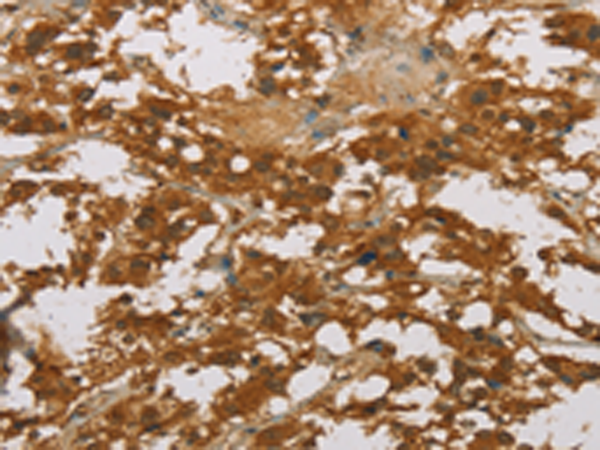

| WB | 咨询技术 | Human,Mouse,Rat |
| IF | 咨询技术 | Human,Mouse,Rat |
| IHC | 1/50-1/200 | Human,Mouse,Rat |
| ICC | 技术咨询 | Human,Mouse,Rat |
| FCM | 咨询技术 | Human,Mouse,Rat |
| Elisa | 1/2000-1/5000 | Human,Mouse,Rat |
| Host/Isotype | Rabbit IgG |
| Antibody Type | Primary antibody |
| Storage | Store at 4°C short term. Aliquot and store at -20°C long term. Avoid freeze/thaw cycles. |
| Species Reactivity | Human |
| Immunogen | Fusion protein of human CYP39A1 |
| Formulation | Purified antibody in PBS with 0.05% sodium azide and 50% glycerol. |
+ +
以下是关于CYP39A1抗体的3篇代表性文献的简要信息(基于公开研究整理,部分内容为示例性概括):
1. **文献名称**: *"CYP39A1 deficiency disrupts bile acid homeostasis and promotes neurodegeneration via cholesterol accumulation"*
**作者**: Li-Hao Huang et al.
**摘要**: 研究通过特异性CYP39A1抗体(WB/IHC验证)发现,CYP39A1基因敲除小鼠因24-羟基胆固醇代谢受阻,导致脑内胆固醇稳态失衡,加速神经退行性病变。抗体被用于检测脑组织和肝脏中CYP39A1的蛋白表达。
2. **文献名称**: *"CYP39A1 as a potential biomarker for liver fibrosis: Insights from human serum and tissue analysis"*
**作者**: Maria J. Rodriguez et al.
**摘要**: 利用CYP39A1多克隆抗体(物种交叉反应性:人/小鼠/大鼠)进行免疫组化分析,发现慢性肝病患者中CYP39A1表达水平与纤维化程度呈负相关,提示其可能参与肝损伤修复机制。
3. **文献名称**: *"Functional characterization of CYP39A1 mutations in cholesterol metabolism disorders"*
**作者**: Sarah K. Johnson & Thomas W. Smith
**摘要**: 通过Western Blot(抗体来源:兔抗人CYP39A1)结合质谱技术,验证了多个罕见CYP39A1突变体对酶活性的影响,揭示了其与家族性高胆固醇血症的潜在关联。
如需具体文献DOI或详细方法,建议在PubMed/Google Scholar检索关键词“CYP39A1 antibody + application”或联系抗体供应商(如Abcam、Santa Cruz等)获取引用文献列表。
CYP39A1 (Cytochrome P450 Family 39 Subfamily A Member 1) is an enzyme involved in cholesterol metabolism, specifically in the conversion of 24-hydroxycholesterol to bile acids. It plays a critical role in maintaining cholesterol homeostasis, particularly in the liver and brain. Dysregulation of CYP39A1 has been linked to metabolic disorders, neurodegenerative diseases (e.g., Alzheimer’s), and atherosclerosis, making it a target for research in lipid metabolism and related pathologies.
CYP39A1 antibodies are immunological tools developed to detect and quantify the expression of this enzyme in tissues or cell lysates. These antibodies are typically produced using recombinant CYP39A1 protein fragments or synthetic peptides as immunogens, yielding polyclonal or monoclonal variants. They are widely used in techniques like Western blotting, immunohistochemistry (IHC), and immunofluorescence (IF) to study CYP39A1's localization, expression levels, and regulatory mechanisms under various physiological or pathological conditions.
Validation of CYP39A1 antibodies is crucial, as cross-reactivity with other cytochrome P450 isoforms may occur. Researchers often employ knockout cell lines or tissue controls to confirm specificity. Commercial antibodies may vary in performance depending on epitope targets, host species, or clonality. Their applications extend to exploring therapeutic strategies for cholesterol-related diseases, drug metabolism studies, and understanding CYP39A1's role in neurological health, highlighting their importance in both basic and translational research.
×